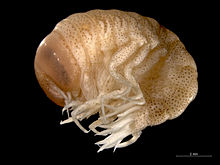| Hyperia | |
|---|---|
 | |
| Hyperia galba | |
| Scientific classification | |
| Domain: | Eukaryota |
| Kingdom: | Animalia |
| Phylum: | Arthropoda |
| Class: | Malacostraca |
| Order: | Amphipoda |
| Suborder: | Hyperiidea |
| Family: | Hyperiidae |
| Genus: | Hyperia Desmarest, 1823 [1] |
Hyperia is a genus of amphipods in the family Hyperiidae. It contains the following species: [2]
- Hyperia bowmani M. Vinogradov, 1976
- Hyperia crassa Bowman, 1973
- Hyperia curticephala M. Vinogradov & Semenova, 1985
- Hyperia fabrei H. Milne Edwards, 1830
- Hyperia galba Montagu, 1815
- Hyperia gaudichaudii H. Milne Edwards, 1840
- Hyperia leptura Bowman, 1973
- Hyperia macrocephala Dana, 1853
- Hyperia medusarum Müller, 1776
- Hyperia spinigera Bovallius, 1889